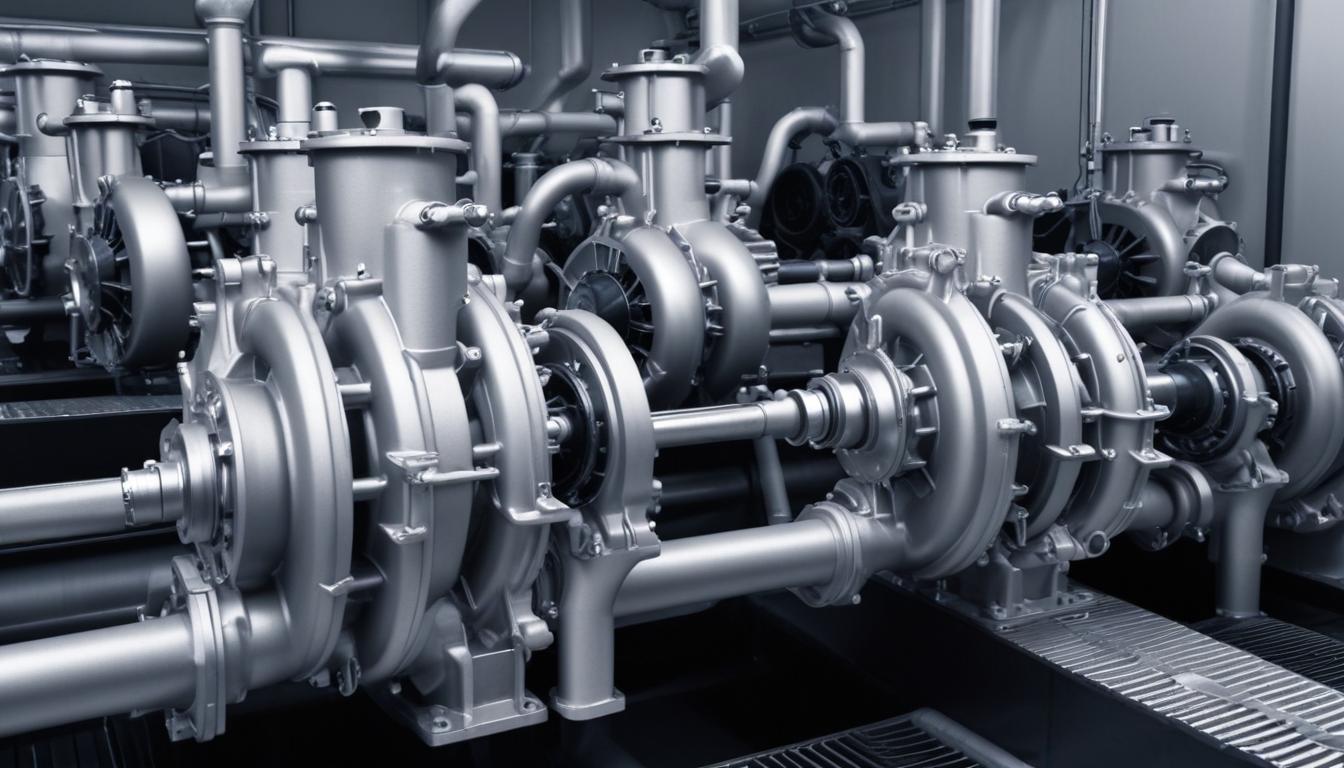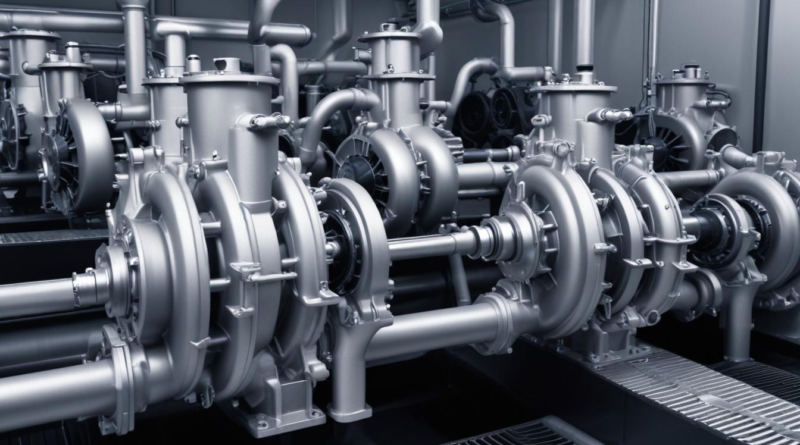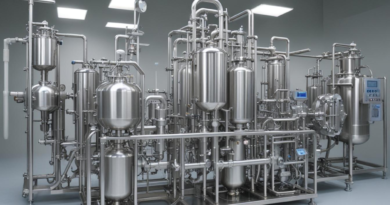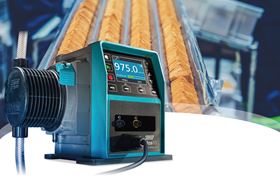pumps used in the automotive cooling system
Automotive cooling pumps are essential components in maintaining optimal engine temperatures and ensuring the vehicle’s performance and longevity. There are several types of cooling pumps used in automotive cooling systems, each with distinct designs and applications tailored to specific engine requirements.
- Mechanical Water Pumps: These are the most common type of cooling pumps found in vehicles. Powered directly by the engine’s crankshaft via a belt, they use a rotating impeller to circulate coolant throughout the engine and radiator. Their straightforward design ensures reliability and ease of maintenance.
- Electric Water Pumps: Unlike mechanical pumps, electric water pumps are driven by an electric motor. This allows for more precise control of coolant flow, enabling better engine temperature regulation and improved fuel efficiency. They are increasingly used in modern vehicles with hybrid and electric powertrains.
- Vane Pumps: Utilizing a series of vanes mounted on a rotor, vane pumps provide a smooth and consistent flow of coolant. They are known for their durability and ability to handle varying pressures, making them suitable for high-performance and heavy-duty automotive applications.
- Gear Pumps: These pumps operate using interlocking gears to move coolant through the system. They are valued for their simplicity and robustness, often found in older vehicle models or applications where cost-effectiveness is a priority.
- Turbine Pumps: Featuring a turbine-like impeller, these pumps offer high flow rates and are capable of handling significant pressure changes. They are typically used in specialized automotive applications where cooling demands are exceptionally high.
| Type of Cooling Pump | Key Features | Common Applications |
|---|---|---|
| Mechanical Water Pumps | Engine-driven, reliable, easy maintenance | Standard passenger vehicles, light trucks |
| Electric Water Pumps | Electronically controlled, precise flow regulation | Hybrid vehicles, electric vehicles, modern engines |
| Vane Pumps | Durable, handles varying pressures | High-performance cars, heavy-duty trucks |
| Gear Pumps | Simplicity, cost-effective | Older vehicle models, budget-conscious applications |
| Turbine Pumps | High flow rates, handles high pressure | Specialized automotive applications, racing engines |
Understanding the different types of automotive cooling pumps allows for better selection and maintenance, ultimately contributing to the vehicle’s efficiency and reliability.
function and operation
Automotive cooling pumps play a crucial role in maintaining the engine’s optimal operating temperature by ensuring continuous circulation of the coolant throughout the engine and the radiator. The primary function of these pumps is to transport the coolant, typically a mixture of water and antifreeze, which absorbs heat from the engine and releases it through the radiator. This heat exchange process is vital for preventing the engine from overheating, which can lead to decreased performance and potential engine damage.
Operation Mechanism
The operation of a cooling pump involves several key components and steps:
- Coolant Circulation: The pump draws coolant from the radiator and pushes it into the engine block where it absorbs heat generated by combustion and friction.
- Heat Absorption: As the warm coolant circulates through the engine, it picks up heat, increasing its temperature.
- Heat Dissipation: The heated coolant returns to the radiator, where airflow helps dissipate the heat before the coolant is recirculated back into the engine.
- Thermostatic Control: A thermostat regulates the flow of coolant based on the engine’s temperature, ensuring efficient cooling without unnecessary energy consumption.
Types of Cooling Pumps and Their Operational Differences
Different types of automotive cooling pumps operate based on distinct principles and mechanisms, offering varying levels of control and efficiency:
| Type of Cooling Pump | Operational Characteristics |
|---|---|
| Mechanical Water Pumps | Driven directly by the engine’s crankshaft via a belt. They provide a constant flow rate proportional to engine speed, ensuring reliable cooling performance. |
| Electric Water Pumps | Powered by an electric motor, allowing for variable speed control. This enables precise regulation of coolant flow based on real-time engine temperature data. |
| Vane Pumps | Use a series of vanes mounted on a rotor to create a smooth and consistent flow. Their design allows for handling varying pressures efficiently. |
| Gear Pumps | Operate using interlocking gears to move coolant. They are simple and robust, providing steady flow suitable for applications with less demanding cooling requirements. |
| Turbine Pumps | Feature a turbine-like impeller for high flow rates and the ability to manage significant pressure changes, making them ideal for high-performance cooling applications. |
Cooling Efficiency Factors
Several factors influence the efficiency of automotive cooling pumps, including:
- Flow Rate: The volume of coolant the pump can circulate per unit of time directly affects the system’s ability to manage engine heat.
- Pressure Handling: The pump must maintain adequate pressure to ensure coolant reaches all critical engine areas and the radiator.
- Energy Consumption: Efficient pumps minimize the energy required to circulate coolant, contributing to overall vehicle fuel efficiency.
- Durability and Reliability: High-quality materials and robust design ensure the pump can withstand the demanding conditions of automotive environments.
Control Systems Integration
Modern automotive cooling pumps are often integrated with advanced control systems to enhance their functionality:
- Engine Control Unit (ECU) Integration: The ECU monitors engine parameters and adjusts the pump’s operation to optimize cooling performance and fuel economy.
- Temperature Sensors: These sensors provide real-time data on coolant temperature, allowing the system to make informed decisions about pump speed and flow rate.
- Smart Cooling Algorithms: Advanced algorithms predict cooling needs based on driving conditions, engine load, and environmental factors, enabling proactive temperature management.
By understanding the intricate functions and operational dynamics of automotive cooling pumps, manufacturers and technicians can ensure the design and maintenance of cooling systems that effectively support engine performance and longevity.
installation and maintenance
Proper installation of automotive cooling pumps is critical to ensure the system operates efficiently and reliably. Before beginning the installation process, it is essential to gather the necessary tools and materials, which typically include wrenches, screwdrivers, coolant, and any specific components required for the particular type of pump being installed.
Step-by-Step Installation Process:
- Prepare the Engine: Begin by disconnecting the vehicle’s battery to ensure safety. Drain the existing coolant from the radiator and engine block to prevent spills and contamination during the installation.
- Remove the Old Pump: Carefully detach the old cooling pump by loosening the mounting bolts and disconnecting the hoses. Take note of the pump’s orientation and connections to ensure correct installation of the new pump.
- Install the New Pump: Position the new pump in place, ensuring it aligns correctly with the mounting brackets. Secure it with the appropriate bolts, tightening them to the manufacturer’s specifications to prevent leaks or vibrations.
- Reconnect Hoses and Electrical Connections: Attach the coolant hoses to the new pump, ensuring they are secure and free from kinks. For electric water pumps, connect the electrical wiring according to the vehicle’s wiring diagram.
- Fill the Cooling System: Refill the radiator and engine block with the appropriate coolant mixture. Bleed the system of any trapped air to prevent overheating and ensure proper circulation.
- Test the Installation: Reconnect the battery and start the engine. Monitor the cooling system for any leaks and verify that the pump operates smoothly, maintaining the correct coolant flow and engine temperature.
Maintenance Practices:
Regular maintenance of automotive cooling pumps is essential to prolong their lifespan and maintain optimal engine performance. Key maintenance tasks include:
- Periodic Inspection: Regularly inspect the pump for signs of wear, such as leaks, unusual noises, or vibrations. Early detection of issues can prevent more extensive damage.
- Coolant Replacement: Replace the coolant at intervals recommended by the vehicle manufacturer. Over time, coolant can degrade and lose its effectiveness in heat transfer and corrosion prevention.
- Drive Belt Tension: For mechanical water pumps, ensure that the drive belt maintains proper tension. A loose or worn belt can reduce pump efficiency and lead to overheating.
- Electrical Connections: For electric pumps, periodically check the electrical connections and wiring for signs of corrosion or damage, ensuring reliable pump operation.
Common Installation and Maintenance Considerations:
| Consideration | Description |
|---|---|
| Compatibility | Ensure the cooling pump is compatible with the vehicle’s engine type and cooling system specifications. |
| Quality of Components | Use high-quality components and genuine parts to ensure reliability and longevity of the cooling system. |
| Proper Sealing | Verify that all connections are properly sealed to prevent coolant leaks, which can lead to overheating and engine damage. |
| System Flushing | When installing a new pump, consider flushing the entire cooling system to remove any debris or contaminants that could impair pump performance. |
| Professional Installation | If unsure about the installation process, seek assistance from a professional mechanic to ensure the pump is installed correctly and safely. |
Adhering to these installation and maintenance guidelines for automotive cooling pumps not only enhances the efficiency of the cooling system but also contributes to the overall reliability and performance of the vehicle. Proper care ensures that the cooling pump functions effectively, preventing engine overheating and extending the engine’s lifespan.
common issues and troubleshooting
 Automotive cooling pumps are vital for maintaining engine temperature, but like all mechanical components, they can encounter various issues over time. Understanding these common problems and effective troubleshooting techniques is essential for ensuring the longevity and reliability of the cooling system.
Automotive cooling pumps are vital for maintaining engine temperature, but like all mechanical components, they can encounter various issues over time. Understanding these common problems and effective troubleshooting techniques is essential for ensuring the longevity and reliability of the cooling system.
Common Issues:
- Leaks: Coolant leaks are a frequent issue, often originating from worn seals, gaskets, or damaged hoses. Leaks can lead to insufficient coolant levels, causing the engine to overheat.
- Noise: Unusual noises such as grinding, squealing, or whining can indicate problems with the pump’s bearings or impeller. These noises often signal that the pump is under strain or is failing.
- Overheating: If the engine consistently runs hotter than normal, it may indicate that the cooling pump is not circulating coolant effectively. This can result from pump failure, blocked coolant passages, or a malfunctioning thermostat.
- Reduced Coolant Flow: A decrease in coolant flow can be caused by a failing pump, clogged hoses, or debris within the cooling system. Insufficient flow reduces the system’s ability to dissipate heat.
- Electrical Issues: For electric water pumps, electrical problems such as faulty wiring, blown fuses, or malfunctioning motors can prevent the pump from operating correctly.
- Corrosion and Deposits: Over time, corrosion or mineral deposits can build up within the pump or cooling system, impeding flow and causing blockages that reduce pump efficiency.
Troubleshooting Steps:
- Identify the Leak Source: Inspect the pump, hoses, and connections for visible signs of coolant leakage. Replace any damaged seals or hoses as needed.
- Listen for Unusual Noises: If you hear grinding or squealing, check the pump’s bearings and impeller for wear or damage. Replacing the pump may be necessary if components are severely worn.
- Check Coolant Levels: Ensure the coolant reservoir is filled to the recommended level. Low coolant can cause the pump to overheat and fail.
- Inspect for Blockages: Examine the radiator and hoses for any obstructions that might restrict coolant flow. Flushing the cooling system can help remove debris and restore proper flow.
- Test the Pump’s Operation: For electric pumps, use a multimeter to check electrical connections and verify that the pump is receiving power. Replace any faulty wiring or components as necessary.
- Examine for Corrosion: Look for signs of corrosion or deposits within the pump housing and replace parts as needed. Using a coolant with appropriate corrosion inhibitors can help prevent future buildup.
- Verify Thermostat Function: A malfunctioning thermostat can affect coolant flow. Ensure the thermostat opens and closes at the correct temperatures to maintain proper engine cooling.
| Issue | Possible Causes | Troubleshooting Steps |
|---|---|---|
| Coolant Leaks | Worn seals, damaged hoses, loose connections | Inspect and replace faulty seals or hoses, tighten connections |
| Unusual Noises | Worn bearings, damaged impeller | Check pump components, replace the pump if necessary |
| Engine Overheating | Pump failure, blocked passages, faulty thermostat | Test pump operation, inspect for blockages, verify thermostat functionality |
| Reduced Coolant Flow | Clogged hoses, failing pump, debris in system | Flush the cooling system, inspect and replace the pump if needed |
| Electrical Problems (Electric Pumps) | Faulty wiring, blown fuses, motor issues | Check electrical connections, replace damaged wires or fuses, test the motor |
| Corrosion and Deposits | Old or poor-quality coolant, lack of inhibitors | Flush the system, use appropriate coolant with corrosion inhibitors |
Preventive Measures:
To minimize the occurrence of issues with automotive cooling pumps, consider the following preventive strategies:
- Regular Maintenance: Adhere to the vehicle manufacturer’s recommended maintenance schedule, including coolant replacement and system inspections.
- Use Quality Coolant: Opt for high-quality coolants that include corrosion inhibitors to protect the cooling system components from deterioration.
- Monitor Coolant Levels: Frequently check coolant levels and top up as necessary to ensure the system operates efficiently.
- Inspect Components: Regularly inspect hoses, belts, and connections for signs of wear or damage and replace them promptly to prevent leaks and failures.
- Keep the System Clean: Periodically flush the cooling system to remove debris and prevent the buildup of deposits that can impair pump performance.
Implementing these troubleshooting techniques and preventive measures can help maintain the effectiveness of automotive cooling pumps, ensuring your vehicle remains reliable and operates within optimal temperature ranges. Addressing issues promptly not only prevents engine damage but also extends the lifespan of both the cooling pump and the overall cooling system.
future trends and innovations
The automotive cooling pump landscape is rapidly evolving, driven by advancements in technology and the shifting demands of modern vehicles. Emerging innovations are set to enhance the efficiency, reliability, and integration of cooling systems within automotive applications.
Electrification and Integration with Hybrid Systems
As the automotive industry moves toward electrification, electric water pumps are becoming increasingly prevalent. These pumps offer precise control over coolant flow, which is essential for managing the thermal demands of hybrid and electric powertrains. Unlike mechanical pumps, electric variants can be dynamically adjusted based on real-time engine and battery temperatures, leading to improved energy efficiency and reduced fuel consumption.
Smart Cooling Systems
Integration of smart technologies is revolutionizing automotive cooling pumps. Equipped with advanced sensors and connected to the vehicle’s Engine Control Unit (ECU), these systems can monitor and adjust cooling parameters autonomously. Features include:
- Adaptive Flow Control: Automatically adjusts pump speed to match engine load and driving conditions, optimizing cooling performance while minimizing energy usage.
- Predictive Maintenance: Utilizes data analytics to predict potential pump failures or maintenance needs, reducing downtime and enhancing system reliability.
- Remote Monitoring: Allows for real-time tracking of cooling system performance through connected devices, enabling proactive management and troubleshooting.
Advanced Materials and Design
Innovations in materials science are contributing to the development of more durable and efficient cooling pumps. The use of lightweight, corrosion-resistant materials such as high-grade aluminum alloys and advanced polymers enhances pump longevity and performance. Additionally, redesigned impellers and housings improve fluid dynamics, resulting in increased flow rates and reduced energy consumption.
| Innovation | Description | Benefits |
|---|---|---|
| Lightweight Materials | Use of aluminum alloys and advanced polymers in pump construction. | Reduces overall vehicle weight, improves fuel efficiency, and enhances pump durability. |
| Enhanced Impeller Designs | Redesigning impellers for better fluid dynamics. | Increases coolant flow rates and reduces energy consumption. |
| Corrosion-Resistant Coatings | Application of specialized coatings to pump components. | Prevents deterioration from coolant acids and extends pump lifespan. |
Energy Efficiency and Sustainability
With the growing emphasis on sustainability, future automotive cooling pumps are being designed to prioritize energy efficiency. Innovations include:
- Variable Speed Operation: Pumps that adjust their speed based on cooling demand, ensuring that energy is only used when necessary.
- Heat Recovery Systems: Integrating cooling pumps with systems that can recover and reuse waste heat, thereby improving overall vehicle thermal management.
- Eco-Friendly Coolants: Developing pumps compatible with environmentally friendly coolant formulations that reduce ecological impact without compromising performance.
Integration with Autonomous and Connected Vehicles
As vehicles become more autonomous and interconnected, cooling systems must adapt to new operational profiles. Future trends include:
- Enhanced Thermal Management for Advanced Driver-Assistance Systems (ADAS): Ensuring that cooling pumps can handle the additional thermal loads generated by ADAS components.
- Vehicle-to-Everything (V2X) Communication: Allowing cooling systems to communicate with external infrastructure and other vehicles to optimize cooling based on traffic conditions and environmental factors.
- Scalable Cooling Solutions: Developing modular cooling pump systems that can be easily scaled to meet the diverse cooling needs of various autonomous vehicle models and platforms.
Emerging Types of Cooling Pumps
New types of cooling pumps are emerging to meet the evolving demands of automotive applications:
- Magnetic Drive Pumps: Utilize magnetic coupling to transfer torque without mechanical seals, reducing the risk of leaks and enhancing reliability.
- Piezoelectric Pumps: Employ piezoelectric materials to create precise and rapid movements for coolant circulation, promising high efficiency and compact designs.
- Hybrid Pumps: Combine mechanical and electric pumping mechanisms to leverage the strengths of both types, providing robust performance across a wider range of operating conditions.
Conclusion
The future of automotive cooling pumps is marked by significant technological advancements aimed at enhancing efficiency, reliability, and integration with modern vehicle systems. As automotive cooling pumps continue to evolve, they will play an increasingly critical role in supporting the performance and sustainability of next-generation vehicles.




